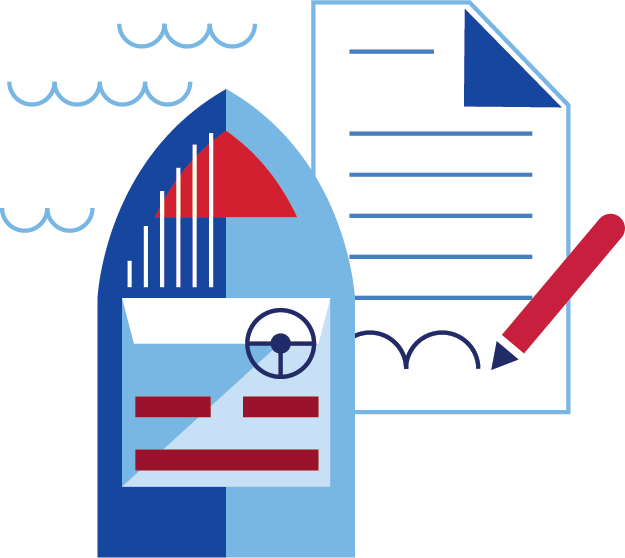Introduction:
For many water enthusiasts, owning a boat is a lifelong dream. However, the substantial upfront cost often leads potential owners to explore boat financing options. The boat financing industry plays a vital role in facilitating boat ownership through loans. In this article, we will delve into the workings of the boat loan industry, the evaluation criteria used by financial institutions, the risks they face from a vessel perspective, and why boat financiers may approve or deny boat financing applications.

Understanding the Boat Financing Industry:
The boat financing industry comprises financial institutions, including banks and specialized lenders, that provide loans to individuals and businesses for purchasing boats. These loans are typically secured by the vessel itself, making them asset-based loans. The availability of financing options varies based on factors such as the borrower’s creditworthiness, the type of boat, its age, and the loan amount.
Financial/Bank Companies and their Evaluation Criteria:
When it comes to evaluating boat financing applications, financial institutions employ various criteria to assess the risk and viability of the loan. Here is a more detailed explanation of the evaluation factors used by these companies:
- Creditworthiness: Financial institutions carefully analyze the borrower’s creditworthiness to determine their ability to repay the loan. This assessment includes reviewing the borrower’s credit history, credit score, and debt-to-income ratio. A higher credit score and a positive credit history demonstrate responsible financial behavior, making the borrower more attractive to lenders.
- Down Payment: Lenders typically require a down payment for boat loans. The down payment amount is usually a percentage of the boat’s purchase price, ranging from 10% to 20%. A larger down payment reduces the loan-to-value ratio, decreasing the lender’s risk exposure. It also shows the borrower’s commitment to the investment, increasing the likelihood of loan approval.
- Vessel Type and Age: Financial institutions consider the type and age of the boat being financed. Newer boats generally have a higher chance of loan approval due to their higher market value and reduced maintenance and repair requirements. However, lenders may have restrictions on the maximum age of the boat they are willing to finance, as older vessels are more prone to depreciation, increased maintenance costs, and reduced market demand.
- Loan Amount: Lenders assess the loan amount requested by the borrower in relation to the boat’s value and the borrower’s creditworthiness. Financial institutions generally have limits on the maximum loan amount they are willing to provide, often based on a percentage of the boat’s appraised value. The loan amount should be within these limits to mitigate the lender’s risk.
- Debt Service Coverage Ratio (DSCR): For commercial boat financing, lenders may evaluate the borrower’s DSCR. This ratio compares the borrower’s cash flow or income to the debt payments associated with the boat loan. A higher DSCR indicates a lower risk for the lender, as it demonstrates the borrower’s ability to cover the loan payments comfortably.
- Use of the Boat: The intended use of the boat can also affect the lender’s evaluation. Different types of boats, such as personal pleasure craft, fishing vessels, or commercial boats, may carry different levels of risk. Lenders consider the purpose of the boat and the associated risks associated with its usage.
- Insurance Requirements: Financial institutions typically require borrowers to have insurance coverage for the financed boat. The lender may specify certain insurance requirements to protect their interests in case of damage, loss, or liability.

By carefully assessing these evaluation criteria, financial institutions can determine the level of risk associated with a boat financing application. The goal is to ensure the borrower’s ability to repay the loan while minimizing the lender’s exposure to potential defaults and financial losses.
Risks from a Vessel Perspective:
When considering boat financing, financial institutions take into account the risks associated with the vessel itself. Here are some specific factors that impact the risks from a vessel perspective:
- Depreciation: Boats, like many other vehicles and assets, tend to depreciate over time. The depreciation rate can vary based on factors such as the boat’s age, make and model, maintenance history, and market demand. The risk for lenders is that if the borrower defaults on the loan and the boat needs to be repossessed and sold, the resale value may be lower than the outstanding loan balance. This situation can result in a financial loss for the lender.
- Age and Condition: Older boats, typically those over 20 years old, may pose higher risks for financiers. As boats age, they may require more frequent repairs and maintenance, increasing the likelihood of unexpected expenses. Additionally, the market demand for older boats tends to decrease, which can further impact their resale value. Lenders may have more stringent requirements or limitations on financing older vessels due to these risks.
- Market Volatility: The boat market is subject to market fluctuations, economic conditions, and changes in consumer preferences. If there is a downturn in the boat market or a shift in consumer demand, it can impact the resale value of boats. Lenders consider these factors when evaluating the risk of financing a particular vessel, as it may affect their ability to recover the loan amount in the event of default.
- Maintenance and Repairs: Boats require regular maintenance and occasional repairs to stay in good working condition. Neglecting proper maintenance can lead to a decrease in the boat’s value over time. Lenders are aware of the potential risks associated with poorly maintained vessels, as it may impact the resale value and increase the likelihood of mechanical issues or breakdowns.
- Environmental Factors: Depending on the geographical location and usage of the boat, environmental factors such as saltwater exposure, extreme weather conditions, and corrosive elements can impact the longevity and condition of the vessel. Lenders may consider the potential risks associated with specific environmental factors when evaluating the loan application.

It is important to note that while these risks exist, lenders assess them on a case-by-case basis, taking into account the specific details of the boat, the borrower’s creditworthiness, and other factors. Boat financiers aim to manage these risks while providing suitable financing options to potential buyers, striking a balance between fulfilling the borrower’s dream of boat ownership and mitigating their own exposure to financial risk.
Lending Limits and Term Limits:
Lending limits and term limits are important considerations in boat financing, as they determine the parameters within which financial institutions operate. Here is a more detailed explanation of lending limits and term limits and how they relate to the risks that lenders consider:
- Loan-to-Value Ratio (LTV): Lenders typically establish lending limits based on the loan-to-value ratio (LTV). This ratio represents the percentage of the boat’s appraised value that the lender is willing to finance. Lenders often offer loans covering 80% to 90% of the boat’s value, requiring borrowers to provide the remaining amount as a down payment. Setting lending limits based on the LTV helps lenders mitigate risk by ensuring that borrowers have a financial stake in the boat and reducing the potential for negative equity.
- Maximum Loan Amount: Financial institutions also establish maximum loan amounts based on factors such as the borrower’s creditworthiness, the value of the boat, and their own internal lending policies. The maximum loan amount ensures that lenders do not overexpose themselves to high-risk loans that may be difficult to recover in the event of default. The loan amount requested by the borrower should align with the lender’s maximum loan amount to increase the chances of approval.
- Term Limits: Term limits refer to the duration of the boat loan or the repayment period. Boat loan terms typically range from 3 to 20 years, although some lenders may offer longer terms for higher loan amounts. The term limit chosen affects the monthly payment amount and the total interest paid over the life of the loan.
- Shorter term limits: Shorter loan terms, such as 3 to 5 years, generally result in higher monthly payments but allow borrowers to pay off the loan more quickly. Lenders may prefer shorter terms as they reduce their exposure to the risk of default and depreciation over an extended period. Shorter terms also minimize the likelihood of the boat’s value decreasing significantly before the loan is fully repaid.
- Longer term limits: Longer loan terms, such as 10 to 20 years, spread out the payments over a more extended period, resulting in lower monthly payments. However, longer terms also come with increased risks for lenders. The longer the loan term, the higher the exposure to potential depreciation of the boat’s value and market fluctuations. If the borrower defaults on a long-term loan, the lender may struggle to recover the outstanding loan balance due to the diminished value of the boat.

It is crucial for borrowers to understand the relationship between term limits, monthly payments, and the overall cost of the loan. While longer terms may seem appealing due to lower monthly payments, they can result in higher overall interest payments and greater exposure to the risks associated with depreciation and market volatility.
Financial institutions carefully consider lending limits and term limits to strike a balance between providing borrowers with manageable financing options and mitigating their own risk exposure. Aligning loan amounts and terms with the lender’s limits and considering the risks associated with longer terms can increase the likelihood of loan approval while protecting both the borrower and the lender.
Approval or Denial of Boat Financing:
Boat financiers assess and weigh the risks and factors mentioned above to determine whether to approve or deny boat financing applications. Factors such as a good credit history, a substantial down payment, choosing a newer vessel, and falling within the lender’s lending limits increase the chances of approval. Conversely, poor credit, low down payment, older vessels, and exceeding lending limits may result in denial or more stringent loan terms.
Boat Financing Summary:
The boat financing industry enables individuals and businesses to realize their dreams of boat ownership. Financial institutions carefully evaluate loan applications, considering factors such as creditworthiness, down payment, and the type and age of the vessel. They face risks associated with depreciation, maintenance, and market volatility. Understanding lending limits and term limits assists borrowers in aligning their expectations and increases their chances of securing boat financing. Longer loan terms amplify the lender’s risk exposure, particularly due to the potential impact of depreciation on the boat’s value after 20 years of age. By navigating these factors and risks, borrowers can better navigate the boat financing industry.
Check out our articles library for more content on all things boating!





No Comments